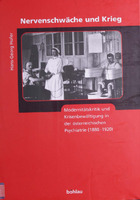Nervenschwäche und Krieg
Modernitätskritik und Krisenbewältigung in der Österreichischen Psychiatrie (1880-1920)
Author(s)
Hofer, Hans-Georg
Collection
Austrian Science Fund (FWF)Language
GermanAbstract
Since the 1880s neurasthenia - a term popularised by New York-physician George Beard - was discussed an a phenomenon of modernity, but over a long period of debate, psychiatry were not able to define what this "modern malady" exactly meant nor was it able to find any discernible causes for the epidemic disease. Neurasthenia was not simply a diagnostic term, which was often applied by fin de siècle-physicians to their workaday routine, but a kind of lifestyle, a sign of a certain emotional sensitivity in modern times. In the last decade historical research on neurasthenia has focused on Britain, Germany and the Netherlands. But what happened in Austria-Hungary, especially in Vienna? Focusing on Viennese psychiatry, part one of the book analyses the "invention" of Neurasthenia and the adoption of Beards thesis in Austrian medicine, bringing out various figures and alternative methods of explanations of the disease that was identified as a central, yet unwanted feature of modern manliness. Based on this the outcome of war could be seen as an instance of 'nerve-corrections'. Like many medical professionals in Austria-Hungary, psychiatrists had reacted to the war with nearly unanimous support: patriotic habits went hand in hand with high psychiatric expectations of the powerful mental effects of war. These hopes were badly disappointed.
In the more recent literature on the medical and cultural history of the Great War, the phenomenon of the epidemic mental breakdowns of soldiers has been given a prominent place. 'Shellshock' and 'war neurosis' are now key words and frequent metaphors for the shattering effects of an industrialized war. In a sense these psychiatric labels symbolically represent the destructive impact of mechanized weapons on body and soul, the loss of narrative structures and the traumatic after-effects of modern warfare. How can Viennese-centred Austrian psychiatry in the First World War be characterized? With regard to new studies on the history of trauma, war and psychiatry I intend to emphasize two interpretations. Firstly, as in German and other European psychiatric war communities, models of rationalisation and modernisation are of significance when focusing on this topic. Viennese psychiatrists were neither particularly brutal nor especially tolerant in the way they dealt with the situation. Instead, as in other European countries in the Great War, they acted in keeping with military requirements and standards. Secondly, the specific political and cultural context of the Austro-Hungarian situation is of utmost importance as well. Shell-shock was a phenomenon that affected all nations, but reactions differed according to different national traditions and different medical ways of understanding, representing and acting. In a comparative cultural history of World War One, Austria-Hungary is a model of a shattered society, paralysed by ethnic conflicts and cultural differences. In this context, the therapeutic response to war neurosis was affected by language confusion, national stereotypes and malingering. The German-Austrian psychiatrists not only emerged as a group of experts who had taken responsibility for the efficient treatment of war neurosis, but also as a pressure group that intended to keep centrifugal forces of the multinational empire under control. Das Unbehagen an der Moderne hatte um 1900 einen Namen: Neurasthenie. Dieses Buch führt in die unruhigen mentalen Landschaften Kakaniens und thematisiert als zentrale Fragen: Wie wurde die Neurasthenie in den österreichischen Ärztemilieus debattiert? Was hieß es für Patienten, mit dieser Diagnose konfrontiert zu sein? Neurasthenie stand für die Erschöpfung der modernen städtischen Gesellschaft, die sich durch eine rastlose Lebensführung überfordert sah, und machte ihre emotionalen Sensibilitäten und Sicherheitsbedürfnisse transparent. Insbesondere Männer des Bürgertums griffen auf das neue psychiatrische Deutungsangebot zurück. Die Diagnose der Neurasthenie konnte "unmännliche" Verhaltensweisen sinnstiftend erklären. Zugleich ließ sie aber auch Bedürfnisse nach deren Überwindung entstehen. Im Spiegel dieser Nervendiskurse lässt sich besser verstehen, warum 1914 der Krieg als "therapeutisches Erlebnis" und männliches Erneuerungsprojekt angepriesen wurde. Die Realitäten des modernen Maschinenkrieges setzten diesen Vorstellungen ein rasches Ende: Der Zitterer wurde zu einer massenhaft auftretenden Erscheinung, zum umstrittenen Patienten und zur Krisenfigur der Abhärtungsutopisten, die aus dem Krieg den "neuen Menschen" hervorgehen sahen.
Da die Militärs in den Kriegsneurosen eine gefährliche Schwächung der Schlagkraft der Armee sahen, wurden wissenschaftliche Experten gebraucht, die rasch und effizient mit diesem Problem umgehen konnten. Die Psychiatrie befand sich dadurch in einer völlig neuen Situation, da sie nicht nur Kritik an einer gesellschaftlichen Krisensituation formulieren konnte, sondern auch Ressourcen und Instrumentarien zu deren Bewältigung bereitzustellen hatte. Welche Akzentverschiebungen ergaben sich in der psychiatrischen Wahrnehmung und Deutung sowie im Umgang mit Nervenkrankheiten? Wie lässt sich die österreichische Psychiatrie des Ersten Weltkriegs in historischer Perspektive charakterisieren? Mit Bezug auf die neuere medizinhistorische und kulturwissenschaftliche Forschung wird die Kriegspsychiatrie auf der Folie der Herausbildung der Medizin als Schlüsselwissenschaft des modernen Krieges analysiert. Dies bedeutete, dass die therapeutische Arbeit der Psychiater an den Vorgaben und Zielvorstellungen des Krieg führenden Staates ausgerichtet war. Darüber hinaus wird auf einige Problemkonstellationen des Vielvölkerstaates und deren Auswirkungen auf psychiatrisches Handeln im Krieg eingegangen. Die elektrischen Behandlungsmethoden der Psychiater werden auf der Folie der ethnisch-sprachlichen Pluralität der österreichisch-ungarischen Armee diskutiert. Der zweite Teil der Arbeit bietet solcherart eine differenzierte Analyse und Neubewertung des Phänomens der "Kriegsneurosen" wie auch der Rolle der österreichischen Psychiatrie im Ersten Weltkrieg.
Keywords
neurasthenia; fin de siècle-physicians; Viennese psychiatry; Nervosität; WienDOI
10.26530/oapen_437155ISBN
3205772148OCN
761034443Publisher
BrillPublisher website
https://brill.com/Publication date and place
2004Grantor
Imprint
BöhlauClassification
Psychology


 Download
Download